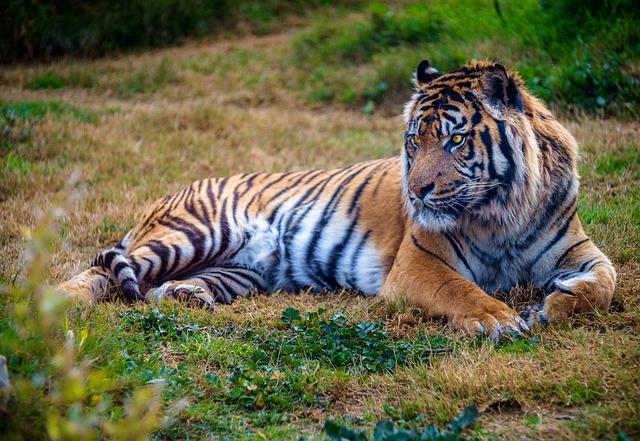Within the middle of West Africa,a silent disaster unfolds because the area’s distinctive tom cat species face the twin threats of armed clash and a chilling loss of analysis. Regardless of their an important position in keeping up ecological stability and their cultural which means, those ceaselessly enough-overlooked predators are teetering on the point of extinction. As violence disrupts habitats and displaces communities, the pressing want for conservation efforts turns into ever extra urgent. But, the absence of whole research leaves a gaping void in figuring out their populations and behaviors, hampering efficient intervention methods. This newsletter delves into the plight of West Africa’s forgotten pussycats, exploring the intersection of environmental degradation, sociopolitical instability, and the pressing want for centered analysis to safeguard those emblematic species ahead of they vanish altogether.
West Africa’s Hidden Cat Species and Their Position within the Ecosystem
West Africa is house to a lot of lesser-known cat species that play a an important position in keeping up the ecological stability in their habitats. A few of these elusive pussycats come with the African golden cat,the serval,and the hardly observed wildcat.Every of those species contributes uniquely to their setting via controlling prey populations, thus combating overgrazing and supporting biodiversity.Their looking patterns now not simplest lend a hand to control the ecosystem but in addition affect the construction of the meals internet, showcasing their importance past their often-overlooked standing.
Sadly,those hidden pussycats face more than one threats that jeopardize their lifestyles and,in flip,the well being in their ecosystems. From habitat destruction because of agricultural enlargement and urbanization to poaching pushed via the illegal wildlife trade, their survival hangs via a thread. Compounding those problems is the loss of complete analysis and conservation efforts particularly concentrated on those species. With out centered information assortment and protecting measures, the overall extent of the ecological penalties stays in large part uncharted. Underneath is a abstract of key demanding situations going through those distinctive cats:
| Demanding situations | Affects |
|---|---|
| Habitat Loss | Aid of looking grounds and prey availability |
| Poaching | Decline in inhabitants numbers, resulting in larger endangerment |
| Local weather Trade | Altered ecosystems affecting prey species |
| Loss of Analysis | hole in figuring out their habits and conservation wishes |

The Have an effect on of War on Pussycat Populations and Conservation Efforts
The intricate courting between armed clash and natural world conservation can’t be overstated, particularly when inspecting the plight of tom cat populations in West Africa. As violence escalates, habitat destruction and poaching develop into extra pronounced, seriously impacting the survival of those pussycats. Components influenced via clash come with:
- Disruption of conservation techniques
- Greater poaching because of loss of legislation enforcement
- Lack of habitat from army operations and displacement of communities
Additionally, the absence of complete analysis additional complicates the conservation panorama. Many tom cat species stay understudied, which hinders efficient control efforts and policy-making. Key problems stem from:
- Inadequate baseline information on inhabitants numbers
- restricted wisdom of species distribution and habitat necessities
- Poverty and socio-economic demanding situations that pressure communities to milk natural world for survival
| tom cat Species | Standing | Main threats |
|---|---|---|
| african Golden Cat | Endangered | Habitat loss,poaching |
| West African Lion | Seriously Endangered | Human-wildlife clash,diminishing prey |
| Serval | Close to Threatened | Habitat fragmentation,poaching |

Figuring out Analysis Gaps and the Want for Complete Research
Regardless of the essential position that West Africa’s pussycats play in keeping up biodiversity, analysis enthusiastic about those species stays alarmingly sparse. The continuing conflicts within the area have additional sophisticated conservation efforts, resulting in a loss of very important information relating to their populations, behaviors, and habitats. Key spaces the place analysis is insufficient come with:
- Inhabitants dynamics and distribution patterns
- Have an effect on of habitat loss and fragmentation because of agricultural enlargement
- Interactions with native communities and farm animals control practices
Moreover, the demanding situations posed via civil unrest and restricted investment have deterred many researchers from pursuing complete research. It’s certainly crucial to prioritize long-term ecological analysis in West Africa to handle those gaps successfully. Collaborative efforts between governments, non-governmental organizations, and native communities may just facilitate information assortment and monitoring, specializing in:
- Organising secure spaces that cater to the original wishes of those species
- Imposing community-based conservation techniques that interact native stakeholders
- Making a centralized database of study findings to tell long term conservation methods

Attractive native populations in conservation efforts is very important for shielding West Africa’s forgotten pussycats, which face threats from each ongoing conflicts and a loss of complete analysis. Group involvement fosters a way of possession and accountability in opposition to local wildlife, remodeling citizens from passive observers into energetic contributors in conservation projects. This may take more than a few paperwork,reminiscent of:
- schooling and Consciousness Systems: Informing communities concerning the ecological significance of those tom cat species and the jobs they play of their native ecosystems.
- Incentive-Primarily based Conservation: Imposing techniques that offer tangible advantages for communities that interact in natural world coverage, reminiscent of eco-tourism alternatives.
- Collaborative Analysis Efforts: Partnering with locals to assemble information, which now not simplest fills analysis gaps but in addition complements network wisdom in their setting.
Additionally, achieved conservation methods require development accept as true with and open traces of verbal exchange between researchers, NGOs, and native communities. for example, making a comments loop the place native wisdom informs medical analysis may end up in simpler conservation practices. An research of community-led projects unearths that:
| Initiative | Have an effect on | Group Engagement Degree |
|---|---|---|
| Natural world Tracking Systems | Greater species consciousness | Top |
| Recovery Actions | Stepped forward native habitats | Medium |
| Group Conservation Workshops | Enhanced abilities and information | Very Top |

Coverage Suggestions for Protective West Africa’s Endangered Cats
to safeguard West Africa’s fragile cat populations, a multi-faceted manner is very important. Key methods should center of attention on improving habitat conservation and addressing the pervasive threats from clash. Governments will have to implement more potent secure house regulation, making sure habitats for species just like the African golden cat and the serval are preserved from logging, agriculture, and human encroachment. Additionally, imposing community-based conservation techniques can empower native populations to have interaction in natural world coverage, fostering a way of stewardship over the herbal sources of their neighborhood.
at the side of habitat coverage, there’s an pressing wish to fill the distance in analysis and knowledge assortment relating to those elusive pussycats. Organising collaborative partnerships with conservation NGOs and analysis establishments can facilitate centered research that assess inhabitants dynamics, genetics, and ecology. Additionally, integrating conventional ecological wisdom with medical analysis may end up in simpler conservation methods adapted to the unique challenges faced via those species. A dedication to public consciousness campaigns too can heighten the visibility of threatened cats, fostering wider network toughen for his or her conservation.

Long run Instructions for Analysis and Conservation Collaboration
The way forward for analysis and conservation collaboration in west Africa gifts a essential alternative to handle the alarming decline of the area’s pussycats. With ongoing conflicts hampering conventional analysis strategies, cutting edge approaches are essential to assemble very important information and put into effect protecting measures. Collaborative efforts will have to center of attention on:
- Attractive native communities: Empowering indigenous populations thru schooling and involvement in conservation projects can foster a way of possession and accountability towards natural world coverage.
- Leveraging generation: Using far flung sensing, GPS monitoring, and digital camera traps can make stronger information assortment efforts in conflict-affected spaces, permitting researchers to observe tom cat actions and behaviour successfully.
- Construction multidisciplinary partnerships: Collaborations amongst ecologists, sociologists, and clash answer professionals may end up in holistic approaches that cope with each ecological and human components influencing tom cat populations.
additionally, setting up a community of regional conservation organizations can streamline data sharing and useful resource allocation.This will have to surround:
- Standardized analysis methodologies: Growing uniform protocols will make sure that information on tom cat populations is constant, facilitating comparative research throughout West Africa.
- Joint investment projects: By way of pooling monetary sources from more than a few stakeholders, together with governments, ngos, and personal donors, greater tasks can also be undertaken, amplifying the affect of conservation efforts.
- Coverage advocacy: Heightening consciousness at nationwide and global ranges may end up in more potent protecting regulation and investment for areas going through environmental degradation.
The belief
As West Africa grapples with escalating conflicts and the urgent demanding situations of local weather exchange, the area’s distinctive tom cat inhabitants unearths itself on the point of extinction. The plight of those often-overlooked species highlights a essential hole in conservation efforts—one this is exacerbated via the shortage of study and investment. With out pressing intervention and a concerted effort to bridge those analysis gaps,the varied and irreplaceable natural world of West Africa may just quickly vanish. Native communities, governments, and global organizations should prioritize the security of those cats and their habitats, fostering a collaborative manner that now not simplest addresses speedy threats but in addition promotes enduring coexistence. By way of elevating consciousness and making an investment in conservation projects, we will make sure that West Africa’s forgotten pussycats are not a footnote within the biodiversity narrative, however a colourful testomony to the area’s wealthy herbal heritage. The time to behave is now, for the way forward for those magnificent creatures hangs within the stability.
Source link : https://afric.news/2025/02/18/west-africas-forgotten-felines-endangered-by-conflict-and-research-gaps-mongabay-com/
Writer : Mia Garcia
Put up date : 2025-02-18 18:43:00
Copyright for syndicated content material belongs to the related Source.



